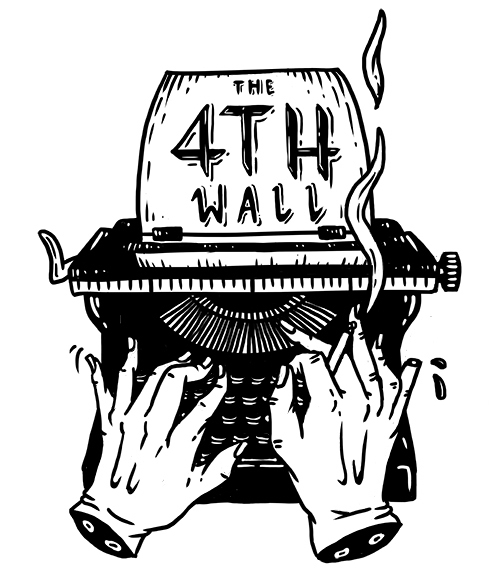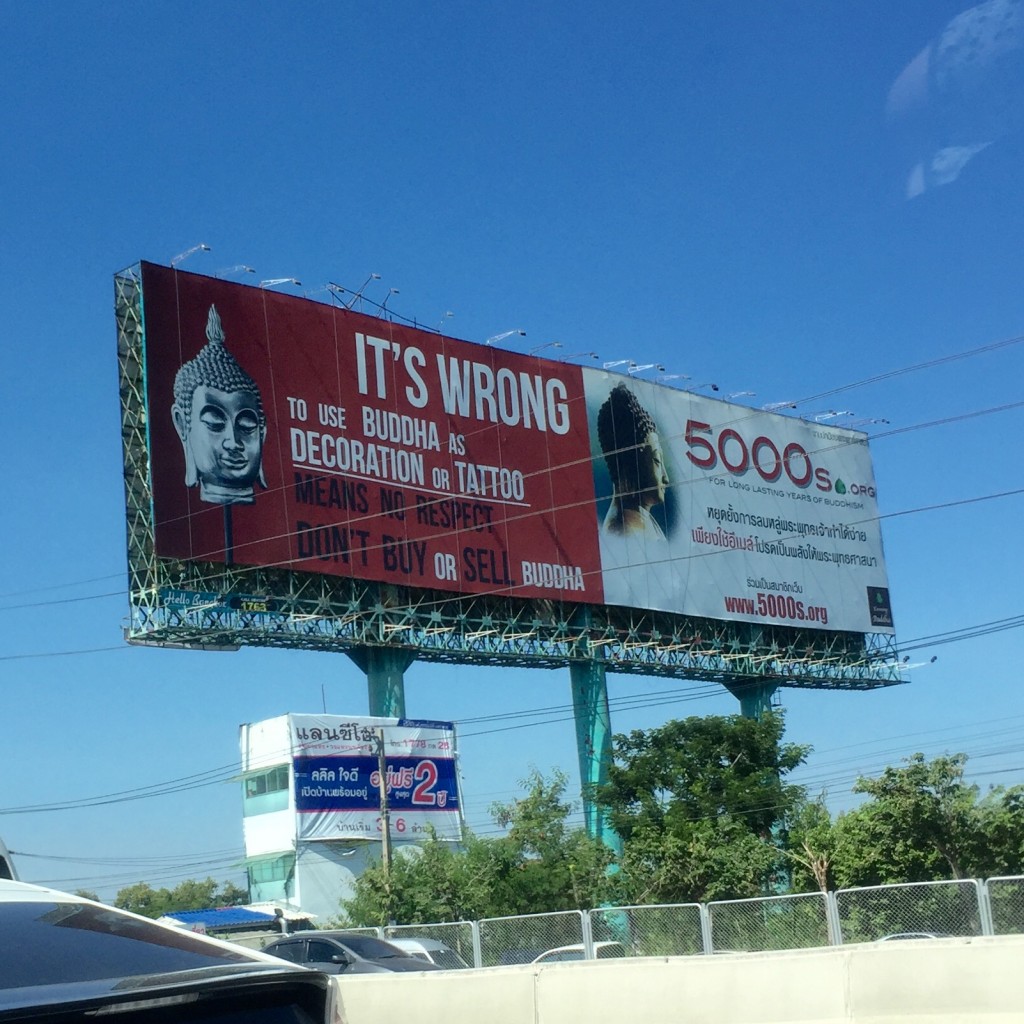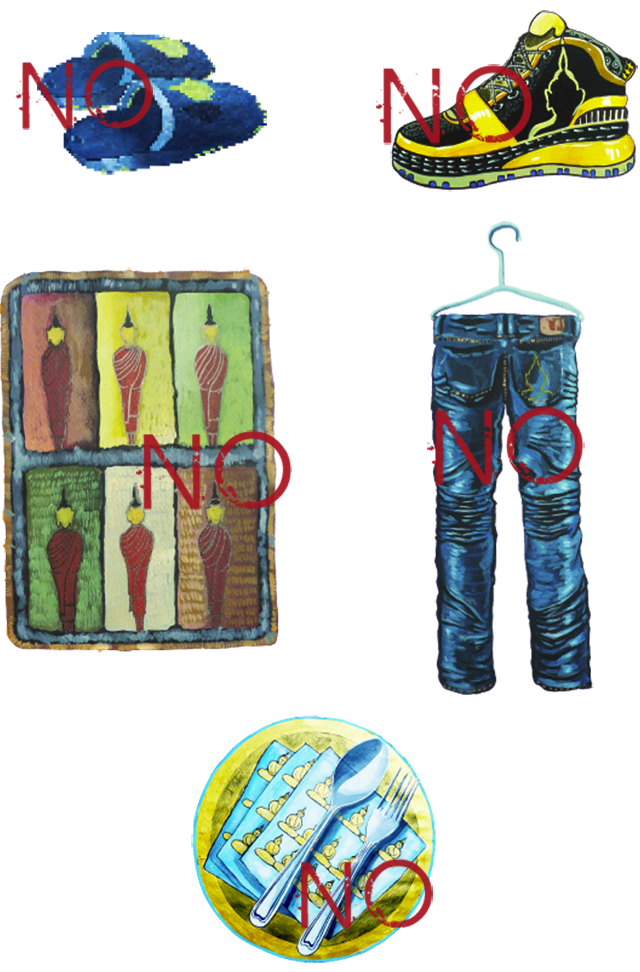The Buddha Tattoo and Other Sacred Images: Sacrilege?
The above billboard is located on Bangkok’s main highway between Suvarnabhumi airport and the city. Confronting travellers entering the city, it condemns any decorative use of the Buddha, including, specifically, tattoos. On their eponymous website, 5000s.org, the organisation that commissioned the public message further elaborate on their position, which is worth quoting in full:
“Buddha is the Father religion of more than 500 million Buddhists around the world. His images and statues are not meant to be used for decoration or tattoo under any circumstance. Those who create the object with Buddha images intend to inspire people to think of Buddha, his teachings. If you feel that Buddha images help you feel peace and harmony please place a Buddha statue properly with respect, by placing the statue or image, at a high level from the floor and not using his symbols as decoration. The human body is dirty. Buddha’s image should not be displayed on something so unclean as the human body, like with a tattoo.”
At this point, it might be important to explore a little further the significance that Buddhist iconography holds within Buddhism. As religious studies academic Patrick S. O’Donnell explains, “The religious meaning of the sundry iconographic representations and symbols are meant to resonate with the practitioner’s psychological, philosophical, and spiritual dispositions and further develop her capacities, which should widen and deepen over time. This iconography is an integral feature of a ‘living tradition’ and not merely ‘art’ in the conventional sense nor solely of historical or antiquarian interest or curiosity.”
Today, however, the Buddha’s image and associated icons have become empty symbols of fashionable spirituality, or further commodified into purely ornamental merchandise and apparel. Recently, North American chain store Urban Outfitters caused controversy for another religion with the release of their US$8 socks featuring the Hindu deity Ganesh (all have since sold out, although US$49 Ganesha tapestries are still available), prompting the President of the Universal Society of Hinduism, Rajan Zed, to release a statement decrying the use of the religious symbol: “Lord Ganesh was highly revered in Hinduism and was meant to be worshipped in temples or home shrines and not to be wrapped around one’s foot.”
For many it may seem like common sense to respect sacred religious iconography, but for others the idea of adapting one’s personal attire to fit within the morally acceptable realm of another’s religion is preposterous; someone taking offence to a picture of an eight-armed elephant on a sock may be valid cause for derision. An investment in exploring the boundaries of cultural appropriation is beyond the scope of this piece, but it is important to keep in mind that the rampant cultural appropriation exhibited by western corporations is their unique way of effacing the world of anything sacred. For the people of historically colonized countries such as India and Sri Lanka, however, who hold continue to revere their religious icons, it’s Colonization 2.0.
In April of this year, the Sri Lankan government arrested and deported a British woman, Naomi Coleman, because of a tattoo of the Buddha on her arm, with a police spokesperson citing the crime of “hurting others’ religious feelings”. And, only last week in Myanmar, the BBC reported that a New Zealander and two locals pleaded “not guilty” to charges of insulting the Buddha by depicting him with headphones (Sri Lanka and Myanmar are deeply religious countries; Burmese law makes it illegal to insult any religion).
Unless your intention is to make a political or social statement—in which case your motivation in visiting a host country is well beyond that of casual tourist or temporary ex-pat—it’s a generally held norm to respect the laws and moral standards of a country in which you are a guest.
The Knowing Buddha Organization (KBO), which operates 5000.org, is a self-proclaimed custodian of the Buddha, dedicated to raising awareness about appropriate and inappropriate uses of Buddhist symbols and imagery. It receives numerous complaints of “devastation” at the sacrilegious use of the Buddha’s image, like statues decorating toilets. The KBO tell me they’re currently working with the Thai Committee on Religions as well as the Thai Senate to “help solve this ongoing problem that has distorted Buddhism worldwide” and to campaign for legislation that will not only focus on tattoos, furnishings, and apparel, but to set a “righteous standard” in public consciousness as a whole.
“To the devoted Buddhists, tattoos are not the means to salvation. They are nothing but unnecessary surplus to life if one wants to detach his mind. For strict regulated Buddhist countries such as Sri Lanka, it is unacceptable to see Buddha and his image in any impur[e context,] including on the body. It is not about reacting emotionally or overacting, but it is about setting the righteous consci[ousness] and good public example. [The Sri Lankan authorities] merely took their stand of demonstrating that such action is disrespectful.”
When I asked the KBO to elaborate on their objection to the depiction of the Buddha in tattoos, they described to me how our bodies are unclean and impure owing to alcohol, defecation, and intercourse. For us to then tattoo a Buddha image on to this vessel of scum (I’m paraphrasing) is to attach the “most sacred symbol of purity to something that is not” and to abase the otherworldly to that which is worldly. Because the Buddha has taught us to “isolate our minds from body and ultimately detach the mind from our mind, to be the mind with no mind,” the KBO questions the impulse to “put his image in such a low and unclean place or [on] something as impermanent as our bodies.”
The pain of seeing the Buddha’s image on an impermanent, dirty material, the KBO explains, is akin to an ardent patriot watching her national flag being trampled or burnt. “Buddha was the purest mind. He is so pure that even his images should be [reverently] treated and placed only [in] high[-up][positions],” commensurate, it suggests, with the spiritual altitude of his righteous deeds.
“The idea of appreciating art from Buddha images is false to the sole purpose and hence is inappropriate. One should consider the true purpose and respect the real meaning.”*
Once again, it boils down to whether or not you’re willing to respect the beliefs of someone else to the point of influencing your own choices. It’s always affirming to see people with such firm beliefs lead by example, so I was confused as to how Sak Yank tattoos and the Buddhists that wear and tattoo them fit in to this seemingly inflexible equation. KBO acknowledges Sak Yant as one of the many misunderstandings of their religion—even among Buddhists—claiming that their charm is misleading.
“As we [delve] deeper toward the core of Buddha’s teaching, we see the inevitable knowledge that real Dharma is to detach the mind from all. Sak Yant is another bond that binds us to our bodies and binds our mind to desire to possess and hope for any expected, extraordinary result. Many genuine Buddhists have Sak Yant, yet they no longer [value] the import of tattoos or their magical claims. They hold only Buddha and his teachings and Dharma as their [salvation].”









